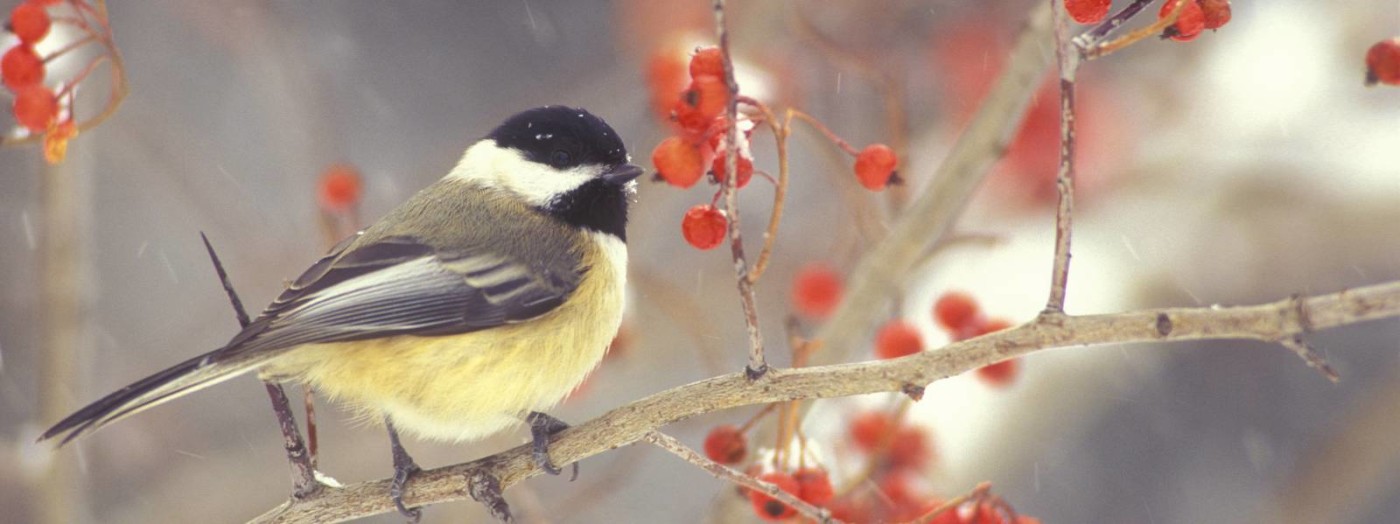Animals and Plants of the Finger Lakes
Winter for Black-capped Chickadees
On the harshest winter mornings, when the air is so cold and dry that it freezes the inside of your nostrils with every breath, the silence of the snow seems almost too loud to bear.
If you listen hard, one of the first things you’re likely to hear are thin, squeaking calls announcing the presence of a flock of Black-capped Chickadees (Poecile atricapillus). How does this bird, so tiny that it could hide in your cupped hand, survive the subzero temperatures and fierce winter winds of the Finger Lakes? The answer: just barely.
Most birds escape cold weather by migrating to the tropics, but these journeys are dangerous and energy-intensive. The chickadee instead lives here year-round, a strategy that is not without its own perils. The calculus of winter is harsh: in order to stay alive, an animal must either produce a lot more heat or lose a lot less of it. However, food is hard to find in the winter and there are only a few daylight hours available for foraging.

In addition, birds have higher metabolisms than we do, and a chickadee’s normal temperature is a feverish 108 °F. To make things even worse, the smaller an animal’s body, the greater its surface-area-to-volume-ratio, and the more quickly it loses heat to the air. These unforgiving laws of physics and biology mean that the diminutive chickadee lives right on the energetic edge in winter. An unusually cold night or a badly-timed snowstorm can mean the difference between death and life.
Luckily, the chickadee has a number of physiological and behavioral adaptations that help it survive. It arises before dawn in order to forage in the half-light and its bold, inquisitive nature seems to give it an edge when it comes to finding food. It is omnivorous and adaptable, able to take advantage of almost any source of nutrition: insects, arthropods, seeds, berries, and even fat and meat from carrion (or suet from feeders). These gregarious birds often feed with other species because more eyes can find more food as well as spot more predators. Chickadees are nothing if not industrious; they cache food items in the autumn for later use, and they squirrel away whatever they can steal from backyard feeders during the winter. It takes a lot of memory to recall the locations of all of those hidey-holes, year after year – chickadees can live for a decade or more – and their tiny brains literally fill up after one season. In order to compensate for a limited amount of storage space, the neurons associated with last year’s caches die off each autumn and new ones grow afresh.

The other part of the winter-survival equation is minimizing heat loss. On sunny days, the chickadee may turn its darker back and wings to the sun. Fat is an excellent insulator, but the chickadee depletes most of its reserves every night just to stay alive. Therefore, its greatest defense against cold is its feathers, which increase in number by twenty-five percent after the autumn molt and are remarkably dense for the bird’s size. Down feathers, with their fluffy, disorganized structure, trap a layer of insulating warm air next to the skin; the outer feathers, with their interlocking barbs and oily coatings, create a shield against water and wind. By fluffing its feathers, the chickadee can increase its insulation and reduce its surface-area-to-volume ratio as long as the weather is neither too windy nor too wet. The eye and beak are poorly insulated, so a bird may close its eyes or tuck its head under its wing. Birds’ feet and legs seem to be insensible to cold surfaces, partly because they are covered with thick scales and partly because blood flow to these extremities is greatly reduced in cold weather. This is possible because a bird’s legs are twigs of bone and sinew, tissues with low metabolic demands; they are controlled like a pair of chopsticks by muscles that are close to the body. In a pinch, the bird may stand on one leg and tuck the other under its breast feathers, or huddle over both feet.
The chickadee stays warm all day by exercising and shivering, but when night falls, it must find shelter. Small, enclosed areas like tree cavities are best, but sometimes, any spot that blocks the wind will have to do. When the temperature drops very low and survival is precarious, the chickadee slips into a state of controlled hypothermia called torpor in which its body temperature falls by about twenty degrees.
Before dawn, the chickadee will emerge from torpor, warming itself to normal body temperature by shivering. With its feathers askew after a long night of squashing itself into a crevice, it will rejoin its mates for yet another day of life on the very edge.
This story by Jacqueline Stuhmiller first appeared in our newsletter, The Land Steward, as part of the Closer Look series about plants and animals of the Finger Lakes region.





